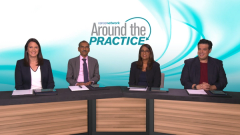
Practical Factors in Selecting Therapy for Relapsed/Refractory MM
Shared insight on key factors that determine the best selection of therapy in patients with relapsed/refractory multiple myeloma, with a focus on bispecific antibodies and CAR T-cell therapy.
Episodes in this series

Transcript:
Sundar Jagannath, MD: Dr Richter, I heard about all the different treatments this patient went through. Some of them sounded a little unusual, [such as] panobinostat and lenalidomide. And there was Kyprolis [carfilzomib] with a drug I have not used before, ibrutinib. In general, could you outline the management of relapsed myeloma? I know a number of triplet therapies [have been] found to be better than doublets in patients who have had 1 to 3 prior lines of therapy. Would you give us some insight into carfilzomib- and pomalidomide-based triplet combinations?
Joshua Richter, MD: Absolutely. Over the last decade, we have seen a number of studies comparing doublets vs triplets in what we would call early relapse ([patients with] 1 to 3 prior lines [of therapy]). As we have no clear optimal guideline for everyone, we [consider] 3 [types of factors] when deciding what regimen to use: patient-, disease-, and treatment-related factors. Is the patient old or young? Fit or frail? [Are there] comorbidities? [In terms of] disease-related [factors], is the disease growing rapidly with a clinical relapse or just a biochemical relapse? [Is it] high risk or not? And [in terms of] treatment-related factors, what have they had before? What were they refractory to in residual toxicities? I think that is one of the big ones. So, if you are refractory to lenalidomide, we often choose a non-lenalidomide regimen in the early relapse, where we can use a number of [FDA-approved] pomalidomide-based regimens: elotuzumab-pomalidomide-dex [dexamethasone], daratumumab-pomalidomide-dex, [and] isatuximab-pomalidomide-dex, as well as some of the other NCCN [National Comprehensive Cancer Network]–listed, but not FDA-approved, [regimens]: KPd [carfilzomib, pomalidomide and dexamethasone] and theOPTIMISMM [clinical trial]regimen of bortezomib, pomalidomide, [and] dex. I think we are using a lot of [anti-] CD38 [monoclonal antibody]–based therapies in early relapse [combined] with IMiDs [immunomodulatory drugs] like pomalidomide. We are now seeing some data supporting that CD38 [-based therapies] combined with carfilzomib may be a little more effective, especially for those with more aggressive, or functional high-risk, [disease]. Today we are talking about people having these amazing responses, but regardless of your cytogenetics, if we expect the first line to last 5 years and you relapse in 1 to 2 [years], you are functionally high risk and need to be treated perhaps a little more aggressively, combining a CD38 [-targeted agent] and carfilzomib. So, either isatuximab and carfilzomib or daratumumab and carfilzomib. I think these are some of the mainstays of regimens that we use in early relapse.
Sundar Jagannath, MD: Thank you very much for that clarification. Now, let’s segue to daratumumab. You talked about frontline use of daratumumab, especially in the elderly. Should we reserve daratumumab for relapse or should we use it up front?
Adriana Rossi, MD: I am going to stick to my original thought. To your point, given that we have a third to a half of patients not getting to a subsequent line of therapy, using our best tools up front is still the best way to address myeloma. So, I think dara [daratumumab] is a very valuable part of induction therapies with whatever combination; we covered quite a few. So, using it up front makes the most sense, and as our collection of salvage therapies expands, our ability to salvage is also getting so much better that I don’t anything should be saved for a rainy day. I would use it up front.
Sundar Jagannath, MD: This is interesting. You are the codirector of a CAR [chimeric antigen receptor] T-cell program, and I do know that 2 CAR T [-cell therapies] against BCMA [B-cell maturation antigen] are already FDA approved and commercially available. One is Abecma, or ide-cel [idecabtagene vicleucel]; the other is Carvykti, or cilta-cel [ciltacabtagene autoleucel]. [Based on] your experience, where do you place the commercially available CAR T vs clinical research against BCMA-bispecific antibodies?
Adriana Rossi, MD: With the commercial agent, we are restricted to the [FDA-approved] indications, so these are patients who are receiving the commercial agent on their fourth line. I think clinical trials that move the CAR T up front [for use in the first line] definitely represent a very exciting area, in my very biased opinion. But any patient [who] is fit enough should go into a clinical trial, be it bispecific or CAR T. I think that is what we believe is best suited. We are very limited, in the commercial space, to [clinical trial] slot availability. So, given how many patients we have and how few slots at the moment, if you are fit for a clinical trial, that would be the [best] decision. Only if you do not have a clinical trial option [should you opt for] a CAR T; hopefully, you’ll be able to access it in a timely fashion.
Sundar Jagannath, MD: Josh, would you compare the use of bispecifics vs CAR T and also give the community an update? For instance, CAR T, being a cellular therapy, would be restricted to FACT [Foundation for the Accreditation of Cellular Therapies]–accredited centers of excellence. And you and Dr Richard told us that CRS [cytokine release syndrome] is much more [common with CAR T], but I have a feeling bispecifics might not be dead. Yet, you showed that bispecifics [cause] CRS too. Do [patients] get CRS every time? Must they be admitted [to the hospital] each time? Would it be much more widely available? How do you look at bispecifics compared [with] CAR T?
Joshua Richter, MD: I think there are a number of factors. One is that currently available CAR Ts are autologous, and they require a manufacturing time that varies between 4 and 8 weeks. This will improve over time. Sometimes we can hold the disease under control in that time and sometimes we cannot. The nice thing about a bispecific is it is off-the-shelf; we can use it right away. But, to your point, we still have to deal with admissions for CRS right now. With essentially all of the bispecific assets, there is a step-up dosing schema where patients either get 1 or 2 step-ups before receiving their cohort dose. They are usually admitted between 24 and 72 hours for each of those doses and are monitored appropriately. Certain protocols admit for the whole step-up program, 10 days, which is quite a lot. I think there are ongoing discussions trying to optimize how we can best do this in an outpatient [setting], and I’m hopeful with optimization and patient selection that at one point we will be able to give this in the outpatient setting, even to community practices. My prediction is the initial outlay of this in a commercial setting will be like the [early] days of daratumumab. When daratumumab was first approved, there were 10-hour infusions. So, patients were often sent to academic centers like ours to get the first few doses, and we sent them back to the community when the infusion rates were shorter. [We are] likely to do the same thing with bispecifics. We will give the first few doses and send them back home to get local therapy.
Sundar Jagannath, MD: Well, daratumumab [is associated with] more infusion reactions, and the duration of administration of the initially released IV [intravenous form] was like 8 hours, which was one of the reasons why they couldn’t [provide it in the outpatient community setting]. With bispecifics, is CRS expected each time or just once you do the step-up and they get it afterward from cycle 2 onward or cycle 3 onward? They could be completely managed outpatient.
Joshua Richter, MD: It is actually somewhat variable. We tend to see [CRS] early on, within the first few cycles. Most patients who get beyond the first few cycles tend not to get it. Interestingly enough, with some of the BCMA-bispecific assets, we’re not seeing any difference in CRS rates. There is no correlation between the CRS rates and the dose given. For example, some of the data for linvoseltamab have shown that whether you get a 5-mg step-up dose, a 50-mg step-up dose, or 200 mg, your CRS rates are the same. It was a bit shocking that a lot of these toxicities are not purely dose dependent. We seem to find that once you get beyond the first few cycles, your immune system has gotten into the groove and [there is a] lower likelihood of CRS.
Transcript edited for clarity.
Newsletter
Stay up to date on recent advances in the multidisciplinary approach to cancer.





















































































